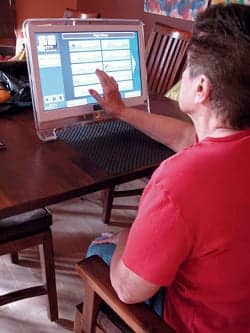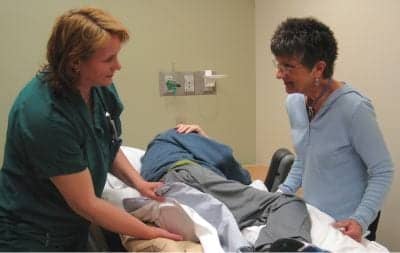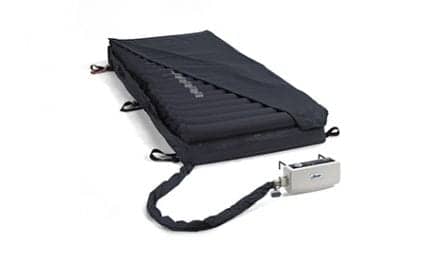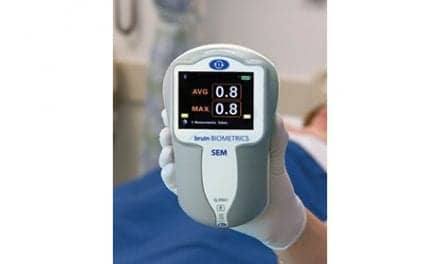By Debra Young, MEd, OTR/L, SCEM, ATP, CAPS

INNOVATIONS FOR A BOOMING POPULATION
Why the boom of innovations for older adults? The reasons are multifaceted, with the first being the national crisis of the largest generation ever to reach retirement age. A Census Bureau report about “The Next Four Decades” states that between 2010 and 2050, the United States is projected to experience rapid growth in its older population. The report further states that in 2050, the number of Americans aged 65 years or older is projected to be 88.5 million, more than double its projected population of 40.2 million in 2010.4 This “silver tsunami” will undoubtedly pose challenges to health care as well as affect families, business, and health care providers.
Research shows there are more than 124 million homes in the housing stock, with a median age of 32 years. The aging population is living longer, with an increase in poor health status and chronic conditions, which limit ability to participate in—or complete—functional activities within a home environment that is also aging. According to the Centers for Disease Control and Prevention (CDC), about 80% of older adults have one chronic condition, and 50% have at least two.5 More than 65 million people—29% of the US population—provide care for a chronically ill, disabled, or aging family member or friend during any given year, and spend an average of 20 hours per week providing care for their loved one.6 Therefore, it comes as no surprise that there is a boom of innovations geared toward assisting millions of people so they may safely remain in their homes as long as possible.
Community mobility is integral to health and wellness and is associated with independence and autonomy. For older adults, limited access to the community because driving is no longer a safe option can lead to depression, isolation, decreased participation in meaningful activities, decreased ability to care for oneself, and diminished wellness.7 This transportation challenge combined with urban sprawl creates an even wider gap, further limiting social connectedness and participation in meaningful activities. AIP technology is an option to bridge this gap. Economic considerations such as outliving one’s money, economic recession, and increasing medical costs also contribute to the growth of AIP technology.
A GROWING TECHNOLOGICAL SPECTRUM
As an OT who specializes in environmental modifications and assistive technology, I am always analyzing products to feature-match them so they meet my client’s current and potential future needs. There are many variables to consider when recommending a product including usability, safety, ease of maintenance, aesthetics, and price. Technology for AIP is no exception. It is imperative to know the user first, then analyze the product to determine how the user’s physical, sensory, and cognitive abilities may impact current and projected future use. The user’s level of “tech-savviness,” along with their overall receptiveness to the use of technology, is integral to successful carryover of use. A holistic approach is needed to ensure the system is flexible enough to meet the current and potential future needs of a variety of household users, including those who are aging or have an illness, injury, or disability.
Currently, there is a large spectrum of AIP technologies. Some of the devices are stand-alone, performing one function and not easily integrated into a system that controls multiple services. Others are all-inclusive—designed to provide a variety of services, with the flexibility of offering a single service initially and ability to expand and provide other services based on a user’s changing wants or needs. These devices can be further classified into systems that are wearable, systems that are embedded in the user’s environment, and/or systems that allow for both. According to the Center for Aging Services Technologies (CAST), devices have been placed into three broad categories based on the relationship these technologies address between the older adult and their environment (safety), oneself (both physical and mental health and wellness), and others (social connectedness).8
Safety technologies, the first of these categories, pursues the goal of enabling independent living and creating safer living environments. According to the CDC, most falls happen at home—every year about 33 million Americans are injured seriously enough to require medical attention. Specifically, falls among older adults cost the US health care system more than $28.2 billion in 2010.9 The integration of environmental modifications, including technology, can help decrease the risk of falls, provide caregiver peace of mind, reduce costs to society, and create a safer home environment.
One example of safety technology is a fall detection system that requires the user to wear a device (such as a pendant or harness) with integrated sensors that continuously monitor the user’s movements and activities. Via technology that measures the changes in height and acceleration, the device is able to discern between typical activity and most falls, and place a call for assistance if a fall (sudden acceleration and change in height) is detected.
Systems that are embedded into the user’s environment utilize wireless motion sensors strategically placed throughout the home. These sensors send information to a caregiver’s laptop, cell phone, or other designated device about the user’s movements within the home. Individualized parameters are set for the sensors to send caregiver alerts based on specific conditions, one of which would be unusual activity in a room and/or lack of activity in a room, indicating the possible result of a fall. Current research also is looking at the idea of a “smart floor,” designed for the ability to detect human falls by monitoring the vibration patterns in a floor.10
Wander management also has created quite a buzz, with many new devices and systems breaking into the market. Determining the tracking techniques (ie, GPS, Wi-Fi, Bluetooth, radio frequency, etc) and deciding on the type of tracking device to be used (ie, cell phone, watch, shoe, etc) are important considerations.11
Home automation is certainly not new, but with the popularity of mobile technologies, an explosion of interest is occurring in this market. New technologies such as stand-alone “smart” thermostats not only are designed to save energy and money, they can now be controlled from inside and outside a home by using a mobile device. They also have larger displays, with text and pictorial representations, and an interface designed to be easier to manipulate than standard thermostats. Other devices, both stand-alone or integrated systems, allow for the monitoring of stove use, smoke, and home air temperature via wireless sensors. Many of these systems also can expand to include door opening, lighting control, and even control of window treatments. Where security systems were once separate from home automation, we are now seeing the marriage of these two markets for a fully integrated system.
MAXIMIZING AN ACTIVE ROLE IN HEALTH
The second category examines technologies that focus on the overall health and wellness of older adults. Similar to the first category, these devices also can be stand-alone or integrated into a full system of services. Some of the most popular gadgets are now connecting to blood pressure cuffs, scales, glucometers, medication dispensers, spirometers, temperature readers, and pulse oximeters to record, analyze, and graph the readings, and then send them to a physician or caregivers.
One case example is a client who transitioned to her son’s home after a major surgery and short-term subacute rehabilitation stay. The client, who previously did not have blood pressure issues, was placed on a blood pressure medication due to postsurgical hypertension. At her son’s home, she was receiving home health nursing care 3 days a week to manage a wound. In an effort to safely come off this medication, the doctor requested daily blood pressures to monitor for changes. The nurse was able to monitor the blood pressure only 3 days a week. The client’s son, although in his early forties, happened to have a previous issue with hypertension. To combat this issue, he changed his diet and also monitored his own blood pressure with a blood pressure cuff that connects directly to a tablet. This device, coincidentally, was now available for his mother to utilize and provide the needed monitoring of her blood pressure. Not only did this device have multigenerational benefit, the connection with mobile technology provided universal appeal and rendered a successful outcome for both the client and her son.
It is imperative to have a thorough knowledge of what devices are currently on the market, and take the time to analyze these products and feature-match the technology to the user’s current and potential future needs. Family and caregivers also must be taken into consideration. A universal design (UD) approach is finding a device or system that would benefit all persons within the household, seamlessly integrating into their lifestyle, while still meeting the client’s needs. This supports successful carryover of use.
STAYING CONNECTED
The last category is social connectedness technologies. Research shows that participation in social activities results in improved physical health and functioning, in terms of activities of daily living (ADLs),12,13 better performance, even if living with a chronic disease,14 and lower mortality rates.15 Furthermore, engaging in social activities also has been shown to improve quality of life.16-18
This category includes all modes of communication (phone, video, text) to keep older adults connected with family, friends, and caregivers. This area also includes social networking Web sites, e-mail, and computer-based cognitive and/or physical stimulation technologies to provide opportunities to connect with peers.8 According to Mary Madden, from Pew, “Social media has the potential to bridge generational gaps. There are few other spaces—online or offline—where tweens, teens, sandwich generation members, grandparents, friends, and neighbors regularly intersect and communicate across the same network.”19
Pew research reports one-third of Internet users aged 65 years or older use social networking sites, and 18% do so on a typical day. Among adults who are currently aged 76 years or older, 20% of the Internet users use social networking sites and 8% do so on a typical day. Pew further reports that e-mail continues to be the backbone of online communication for older adults, with 86% of Internet users aged 65 years or older using e-mail, 48% doing so on a typical day.20
Although not a specific modification to the home, technologies that integrate features that allow for social interaction are becoming increasingly available. We live in a connected world where having a mobile device on your person at any given moment has become commonplace. Multimodal communication options provide flexible access for older adults to keep connected with friends and family, as well as provide peace of mind for caregivers. The addition of social media networking and computer games provides a new approach to recreation and leisure and creates new experiences for keeping the older adult mind engaged.
AUTOMATING MOBILE ACCESS
Many mainstream technology companies are jumping on the home automation and health and wellness mobile app bandwagon, providing consumers with ease of access in controlling their homes and health. Security also is trending, from apps that allow locking and unlocking of doors to a residential keyed entry door lock system with built-in alarm.
The next step is connected homes! This concept is a home in which personalized appliances communicate with one another and alter performance based on who is present in a room.21 We are already seeing the introduction of televisions with Internet, Internet stovetops designed to look up recipes, and Internet refrigerators designed to keep a food inventory. It may soon become possible to connect all of a home’s appliances and electronic technologies and manage everything through a mobile device.
There are also a few companies that have built “caregiver robots,” designed to provide monitoring, automatic reminders, companionship, and emergency notification for family or caregivers. Although this market is in its early stages in the United States, the technology is already being used in Japan to manage that country’s own aging crisis.22 It is no longer purely science fiction, nor your imagination—the Jetsons’ connected home and robot maid Rosie are here!
REFERENCES
1. AARP. A state survey of livability policies and practices. 2011. www.ncsl.org/documents/transportation/Aging-in-Place-2011.pdf
2. Lange ML. The future of electronic aids to daily living. Am J Occup Ther. 2002;56:107-109.
3. International Society for Gerontechnology. http://gerontechnology.info/index.php/journal/pages/view/isghome
4. United States Census Bureau. The next four decades, the older population in the United States: 2010-2050. May 2010. www.census.gov/prod/2010pubs/p25-1138.pdf
5. CDC. Healthy aging: Helping people to live long and productive lives and enjoy a good quality of life. 2011. www.cdc.gov/chronicdisease/resources/publications/AAG/aging.htm
6. Barrett L. Health and caregiving among the 50+: Ownership, use and interest in mobile technology. 2011. www.aarp.org/technology/innovations/info-01-2011/health-caregiving-mobile-technology.html
7. Dickerson AE, Molnar LJ, Eby DW, et al. Transportation and aging: a research agenda for advancing safe mobility. Gerontologist, 2007;47:578–590.
8. LeadingAge: CAST, Aging Services Technologies. www.leadingage.org/SubSection.aspx?id=533
9. CDC. Falls among older adults: an overview. 2010. www.cdc.gov/HomeandRecreationalSafety/Falls/adultfalls.html
10. Alwan M, Rajendran PJ, Kell S, et al. A smart and passive floor-vibration based fall detector for elderly. In: Proceedings of 2nd Information and Communication Technologies Conference, ICTTA 06. April 2006:1003-1007.
11. Center for Technology and Aging. mHealth technologies: applications to benefit older adults. March 2011. www.techandaging.org/mHealth_Position_Paper_Discussion_Draft.pdf
12. Mendes de Leon CF, Glass TA, Beckett LA, Seeman TE, Evans DA, Berkman LF. Social networks and disability transitions across eight intervals of yearly data in the New Haven EPESE. J Gerontol B Psychol Sci Soc Sci. 1999;54:162-172.
13. Mendes de Leon CF, Glass TA, Berkman LF. Social engagement and disability in a community population of older adults—The New Haven EPESE. Am J Epidemiol. 2003;157:633-642.
14. Seeman T, Chen X. Risk and protective factors for physical functioning in older adults with and without chronic conditions: MacArthur Studies of Successful Aging. J Gerontol B Psychol Sci Soc Sci. 2002;57:135-144.
15. Avlund K, Damsgaard MT, Holstein BE. Social relations and mortality: an eleven year follow-up study of 70-year-old men and women in Denmark. Soc Sci Med. 1998;47:635-643.
16. Dahan-Oliel N, Gelinas I, Mazer B. Social participation in the elderly: what does the literature tell us? Critical Reviews in Physical Rehabilitation Medicine. 2008;20:159-176.
17. Silverstein M, Parker MG. Leisure activities and quality of life among the oldest old in Sweden. Res Aging. 2002;24:528-548.
18. Stav WB, Hallenen T, Lane J, Arbesman M. Systematic review of occupational engagement and health outcomes among community-dwelling older adults. Am J Occup Ther. 2012;66(3):301-310.
19. Madden M. Older adults and social media. PEW. 2010. www.pewinternet.org/Reports/2010/Older-Adults-and-Social-Media.aspx
20. Madden M. Older adults and internet use. PEW. 2012. www.pewinternet.org/~/media//Files/Reports/2012/PIP_Older_adults_and_internet_use.pdf
21. Bosker B. CES 2012: Eric Schmidt envisions a home where every gadget knows you. Huffington Post. 2012. www.huffingtonpost.com/2012/01/10/eric-schmidt-ces-2012_n_1198219.html
22. McLeod C. A glimpse of the future: robots aid Japan’s elderly residents. USA Today. 2009. www.usatoday.com/tech/news/robotics/2009-11-04-japan-robots_N.htm
Debra Young, MEd, OTR/L, SCEM, ATP, CAPS, is the owner of EmpowerAbility, LLC in Newark, Del, which provides consultation services to consumers, professionals, and agencies on Universal Design, Aging in Place, assistive technology, and accessibility. She has 17 years of clinical experience and specializes in environmental modifications. [email protected]
Focus on Access and Safety
While advanced technologies can expand an individual’s control over a living space, modifications that provide access throughout the home and promote safety are essential to comprehensive aging in place strategies. Among these are modifications that help homeowners prepare in advance for changes in the daily routine. Options range from stair lifts or ramps installed to assist in mobility between floors or from the exterior to interior, to bathroom enhancements, to door opening devices.
Good preparation also creates a home that can accommodate unanticipated injuries or future disabilities. “A good option is to consider remodeling the house incorporating universal design ideas, such as creating a barrier free entrance and a first floor master suite with an accessible bathroom,” explains Tori Goldhammer, MS, OTR/L, ATP, CAPS, founder of Living At Home Consultations, LLC. “In this scenario, users will have features that will be useful now, and they will be prepared for most situations.”
Bathroom modifications in particular, Goldhammer notes, can be a springboard to creating a space accessible for all ages and abilities. Such modifications include grab bars, transfer devices, walk-in or roll-in showers, and bath chairs. Goldhammer describes grab bars as a simple safety solution that benefit all. “I put them in my house when my daughter started getting in and out of the shower on her own at age 6 and quickly realized that we all use them.” A full bathroom remodel may also present homeowners with the opportunity to integrate universal design features, such as a barrier free shower.
Installation of a safe transfer system can improve transfer safety throughout a home. Ceiling lifts that operate thoughout the home on a continuous track offer one option, while free standing rail systems are designed to accommodate users where walls or ceilings may not be ideal for lift attachment. Mobile lifts can also provide convenience for toileting and dressing/undressing.
Another technology that can resolve access challenges both outside or inside the home is door opening devices. Models designed for remote control allow a mobility device user to open a door, pause it, then close it automatically from a control mounted on the mobility device. To accommodate outside caregivers, some devices are designed with a keyless entry pad that allows access using a combination—which can be quickly changed to assure security.
Door opening devices can also be designed for installation without an electrician’ assistance. Additional features available on the market include the ability to operate on a battery backup, or manual operation with the use of a wall push pad.
—Brittan West





